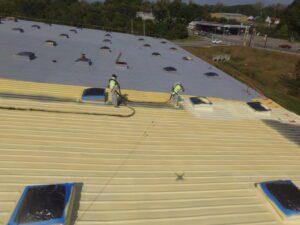HOW WILL YOU INSTALL YOUR NEW ROOF AROUND ROOF PENETRATIONS?
Working on buildings with a large number of roof penetrations is a major headache. They provide another roof feature that must be carefully protected, it means you have to adjust your installation pattern, and have to make sure you get a good seal on whatever new roof you’re installing. Basically, roof penetrations present challenges that don’t exist in clear areas on the roof. Let’s look at these challenges and how foam overcomes them.

Working Around Roof Penetrations is Slow
When installing a new roof system around roof penetrations, you have to take extra time and be very cautious so as to not damage these penetrations. Sure, you should always exercise caution when working on a roof, but especially around roof penetrations that can be damaged or bent, leading to a roof leak. Working around roof penetrations requires additional caution that slows things down.
Installing spray foam around roof penetrations still requires caution, but they don’t slow you down much. Rather than being very careful about where you’re drilling, nailing, hammering, etc., you just have to spray up to it, spray up the edge, and then you’re done. You must slow down slightly around penetrations, but you can apply foam right up the edge of it.
Adjusting Installation Pattern
Roof penetrations present problems for roof installation because they change the pattern you were following. For example, a single-ply membrane is installed in rolls. With no penetrations, you can roll the membrane all the way across the roof without cutting anything. When penetrations get involved, you must begin to cut and manipulate the membrane. They change the installation pattern and slow you down.
You still have to work around roof penetrations when installing spray foam, but you don’t have to change much. Simply change the angle of the gun and spray it around the edges of the penetration, then you’re done.
Ensuring a Good Seal
Most roof leaks occur at the seams and at the penetrations. This is where the membrane had to be cut, bent, molded, or somehow reshaped to tie into the penetration. Whenever you take a membrane that is supposed to be flat and uncut and you cut it and tie it into a penetration, the risk of a leak is there. The membrane is no longer in the position it was designed to be in.
With spray foam, you install it right up onto the penetration. The foam adheres to the roof, the penetration, and itself. It forms a seamless, monolithic surface that doesn’t have seams or cracks at the membranes. Leaks are extremely rare on spray foam roofs for this reason.
Conclusion
Installing a new roof on a building with lots of building penetrations can be time-consuming, difficult, and can produce leaks if you’re not careful. There are several hurdles to overcome with traditional roofing systems, but spray foam can overcome all hurdles thanks to its versatility and installation method. If your roof has a large number of roof penetrations, contact us today to see how spray foam can ease the struggles of your installation process.
